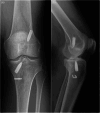Single-stage autograft revision for failed ligament advanced reinforcement system (LARS) anterior cruciate ligament reconstruction: Improved clinical outcomes at a minimum 5-year follow-up
- PMID: 40766804
- PMCID: PMC12322687
- DOI: 10.1002/jeo2.70381
Single-stage autograft revision for failed ligament advanced reinforcement system (LARS) anterior cruciate ligament reconstruction: Improved clinical outcomes at a minimum 5-year follow-up
Abstract
Purpose: To evaluate mid-term clinical outcomes and intraoperative findings in patients undergoing single-stage revision after failed ligament advanced reinforcement system (LARS) anterior cruciate ligament reconstruction (ACLR).
Methods: This retrospective study evaluated patients who underwent ACL revision surgery following initial reconstruction using the LARS device. Clinical assessments included the Tegner activity scale, Lysholm Knee score, and International Knee Documentation Committee (IKDC) scores, recorded preoperatively and at a minimum follow-up of 5 years. Preoperative imaging was conducted to assess tunnel widening, alignment, and the presence of arthritic changes. Intraoperative evaluations included arthroscopic inspection of the synovium, menisci, and cartilage. Synovial biopsies were obtained for histological analysis of inflammation.
Results: Twenty-five patients were included in the study. Clinical scores demonstrated significant improvement in Tegner activity scale (p = 0.0006), Lysholm Knee score (p = 0.0001) and IKDC score (p = 0.0001) following revision surgery, with a mean follow-up duration of 7.8 years (SD = 2.13). Preoperative imaging revealed early arthritic changes in 52% of patients. Intraoperative findings showed that all patients exhibited synovial membrane inflammation, with a 100% incidence of synovitis. Additionally, 68% of patients presented with Stage III or IV chondral lesions according to the ICRS classification.
Conclusions: Single-stage revision ACLR using autografts led to significant clinical improvement after LARS ACLR failure, with a mean follow-up of 7.8 years. All cases during revision demonstrated synovial inflammation, with a high prevalence of chondral lesions and early arthritis. While these findings may point to a potential association between synthetic grafts and degenerative joint pathology, causality cannot be established, as degenerative changes are known to occur following failed ACL reconstructions regardless of graft type.
Level of evidence: Level IV.
Keywords: ACL revision; anterior cruciate ligament reconstruction (ACLR); ligament advanced reinforcement system (LARS); synthetic grafts.
© 2025 The Author(s). Journal of Experimental Orthopaedics published by John Wiley & Sons Ltd on behalf of European Society of Sports Traumatology, Knee Surgery and Arthroscopy.
Conflict of interest statement
The authors declare no conflict of interest.
Figures


References
-
- Ambrosio L, Vadalà G, Castaldo R, Gentile G, Nibid L, Rabitti C, et al. Massive foreign body reaction and osteolysis following primary anterior cruciate ligament reconstruction with the ligament augmentation and reconstruction system (LARS): a case report with histopathological and physicochemical analysis. BMC Musculoskelet Disord. 2022;23:1140. - PMC - PubMed
-
- Andrish JT, Woods LD. Dacron augmentation in anterior cruciate ligament reconstruction in dogs. Clin Orthop Relat Res. 1984;183:298–302. - PubMed
-
- Barrett GR, Line L, Shelton WR, Manning JO, Phelps R. The dacron ligament prosthesis in anterior cruciate ligament reconstruction. a four‐year review. Am J Sports Med. 1993;21:367–373. - PubMed
-
- Blakeney WG, Hayes A, Kop A, Parry J, Walsh M, Annear P, et al. Biomechanical and histological study of retrieved LARS synthetic ligaments. Am J Sports Med. 2024;52:1979–1983. - PubMed
-
- Claes LE, Ludwig J, Margevicius KJ, Dürselen L. Biological response to ligament wear particles. J Appl Biomater. 1995;6:35–41. - PubMed
LinkOut - more resources
Full Text Sources
Research Materials

